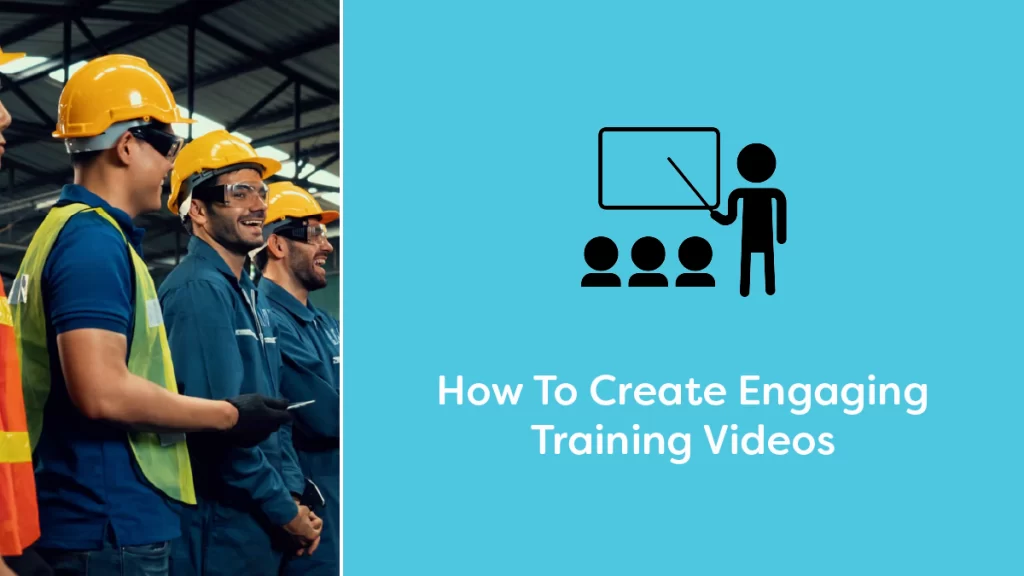How To Create Engaging Employee Training Videos

Training videos are essential tools for businesses to keep their staff up to date with vital company procedures, skills, and compliance requirements.
In particular, for manual labour industries, training videos play a critical role in communicating safety standards and practices.
Regular, engaging training ensures employees can maintain workplace safety, follow protocols, and avoid injuries.
But, to have the desired impact, these videos must be engaging, clear, and tailored to the audience.
Why Are Engaging Training Videos Important?
Engaging training videos improve employee comprehension and retention. The use of visuals, sound, and motion creates a multi-sensory learning experience, making complex information easier to understand.
This is especially crucial in industries like construction or manufacturing, where clear understanding of safety protocols can prevent accidents and save lives.
Research shows that employees are more likely to complete and retain information from video-based training than text-heavy manuals or presentations.
Well-produced videos ensure that key safety standards and job-specific skills are communicated effectively across your entire workforce, regardless of location.
Step 1: Define Clear Objectives For The Training Video
Start by establishing clear goals for the training video. Ask yourself:
- What are the key takeaways for employees?
- Who is the intended audience?
- Which skills or knowledge should they acquire by the end of the video?
For instance, if your goal is to improve workplace safety, ensure your objectives focus on educating employees about specific hazards, proper equipment usage, and emergency procedures.
Having well-defined objectives helps maintain focus throughout the production

Step 2: Plan Your Content And Structure
To create a compelling training video, you need to carefully plan your content. Here’s how to structure it effectively:
Create A Script
A well-written script is essential. Keep the language simple, clear, and concise, avoiding unnecessary jargon. Break your content into small, digestible sections to ensure viewers can follow along without feeling overwhelmed.
Storyboarding
Storyboarding is a crucial step that maps out the video visually. This ensures you’re delivering the key messages through a combination of visuals, on-screen text, and narration. By planning each shot in advance, you avoid unnecessary filming and keep the production process efficient.
Step 3: Keep The Video Short And Focused
In training, shorter is often better. Employee attention spans can be limited, especially when dealing with complex topics.
Focus on creating short, targeted videos that address one specific topic at a time. Aim for videos between 5 and 10 minutes. Ideally, even shorter, less than 2 minutes, if the topic allows for it.
If your training program covers multiple topics, consider breaking them into a series. This way, employees can digest the information in manageable pieces, and you can revisit crucial points without overwhelming them.
Step 4: Incorporate Visual And Interactive Elements
Engaging training videos go beyond just a person talking to the camera. Using various visual and interactive elements can significantly boost viewer engagement.
- Use Graphics and Animations: Adding animations, infographics, and visual aids can clarify complex processes or workflows. For example, demonstrating safety procedures through animations makes the training more understandable for those in manual labour industries.
- Include Quizzes and Polls: Quizzes or polls within the video can reinforce learning by prompting viewers to think actively about the content. This helps them better retain what they’ve just learned.
- B-roll Footage: B-roll footage, such as shots of employees performing tasks or using equipment, enhances the visual appeal and shows real-world applications of what’s being taught.
Step 5: Use Professional Voiceovers and High-Quality Audio
High-quality audio is critical for maintaining viewer engagement. Poor audio quality can make even the best video frustrating to watch, leading to disengagement.
Invest in a professional voiceover artist who can deliver the script clearly and with an appropriate tone.
The tone of the voiceover should match the content of the video. For example, safety training videos may require a more serious, authoritative tone, while onboarding videos for new hires might benefit from a friendly, welcoming approach.
Adding background music is another way to enhance the viewer’s experience. Use subtle, non-intrusive music that supports the video’s flow without distracting from the narration.
Step 6: Customise the Video for Your Audience
Tailoring your video to your audience is essential for keeping them engaged and ensuring they absorb the material. Consider the following:
- Language: Use straightforward language that all employees can understand, especially if some team members are not native English speakers. Subtitles can also help make the content more accessible.
- Cultural Sensitivity: Be mindful of the diverse backgrounds within your workforce and ensure that your video respects different cultural perspectives, especially in global or multi-location companies.
- Accessibility: Make sure your video is accessible to all employees. This includes adding closed captions for those who are hearing impaired and ensuring the video platform is compatible with screen readers.
Step 7: Ensure High Production Quality and Partner with Professionals
The production quality of your training videos directly impacts how seriously employees take the content. Poor-quality videos can reduce engagement, whereas high-quality visuals, audio, and editing will keep viewers attentive and boost the effectiveness of the training.
To ensure high production standards, you may need to partner with a professional video production company. In Melbourne and beyond, our team specialises in producing engaging employee training videos that meet specific business needs.
We guide you through every stage of production, from scripting and storyboarding to editing and adding interactive elements like quizzes or captions.
By working with professionals, you guarantee that your training videos are polished, informative, and aligned with your business goals.
Whether your focus is on safety training, onboarding, or upskilling, we can create content that ensures your workforce remains engaged and well-prepared.
Training Videos Can Make Or Break Your Company
Creating engaging employee training videos is an essential investment in your workforce.
Whether you’re updating staff on safety standards or introducing new procedures, the video format makes complex information easier to digest and retain.
By following the steps outlined in this post—defining clear objectives, planning your content carefully, using engaging visuals, and investing in professional production—you can create training videos that not only inform but also motivate your employees.
Ready to create powerful training videos for your team?
Contact our Melbourne-based video production company today to get started.
